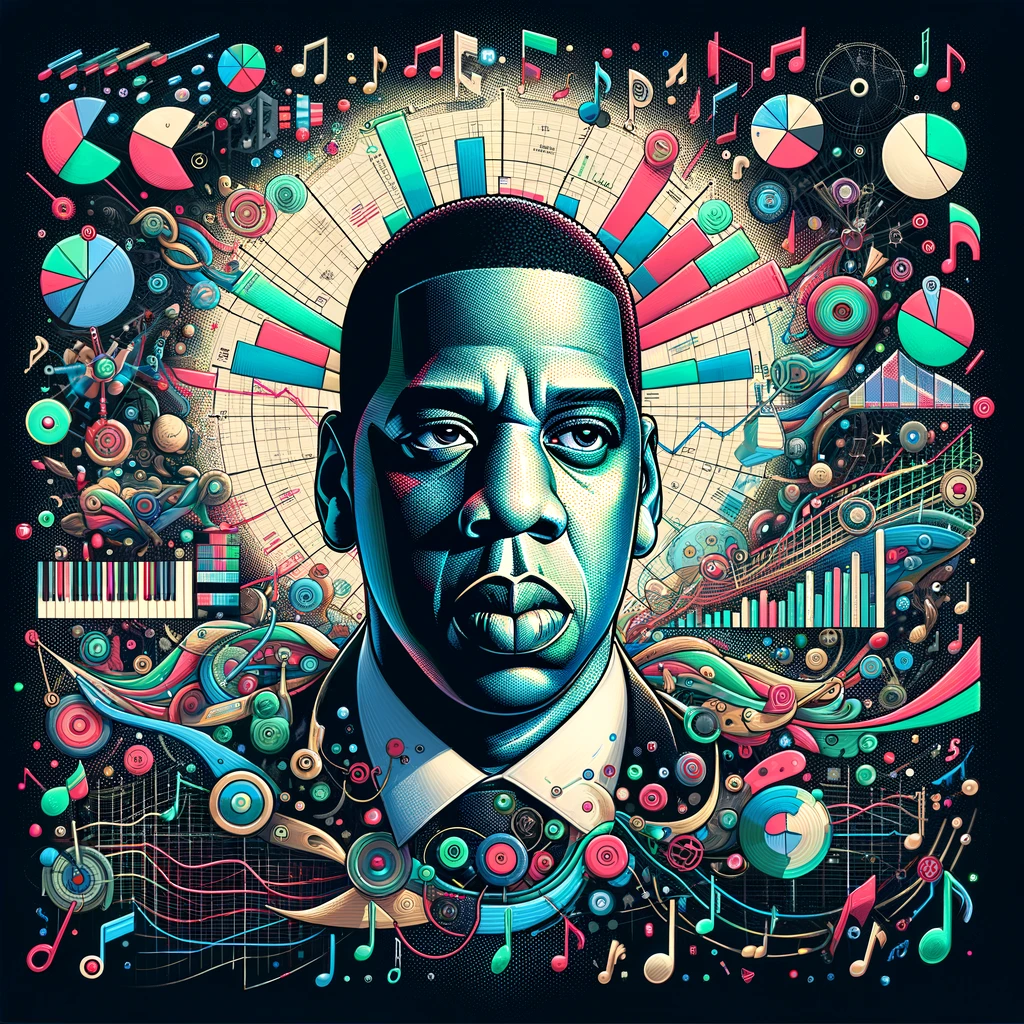
I’m deep diving into a data-driven exploration of Jay’s career, using analysis to peel back the layers of his discography. From ‘Reasonable Doubt’ to the introspective ‘4:44’, my journey is a quest to uncover hidden patterns and trends. By closely examining his work, I aim to shine a light on the stylistic shifts, thematic developments, and the cultural impact that has cemented Jay-Z in the hip-hop world. Join me as I decode the data behind the music, uncovering insights into one of the most influential artists of our era.
Popularity
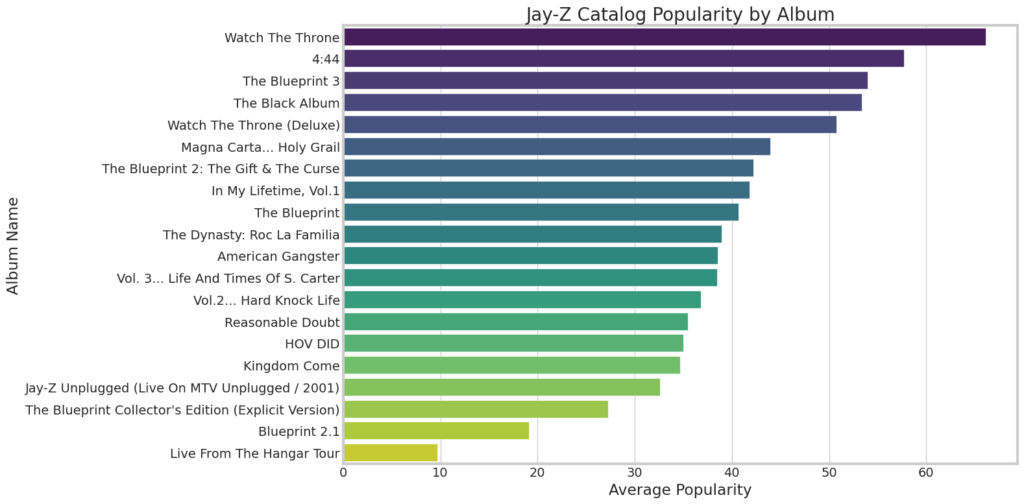
In the world of music streaming, getting a grip on what makes a song or album popular is key for artists, labels, and fans alike. Spotify uses a complex algorithm to figure out just how popular tracks and albums are, looking at details like how many times they’ve been played, how quickly they’re racking up new plays, and how much users are interacting with them. It’s not just about how many times a song’s been played; the algorithm also pays attention to how fast it’s gaining new streams, showing what’s really catching on right now. Plus, it looks at how users are engaging with the music—think saving, liking, sharing, and adding to playlists—which tells us how much listeners actually like a track.
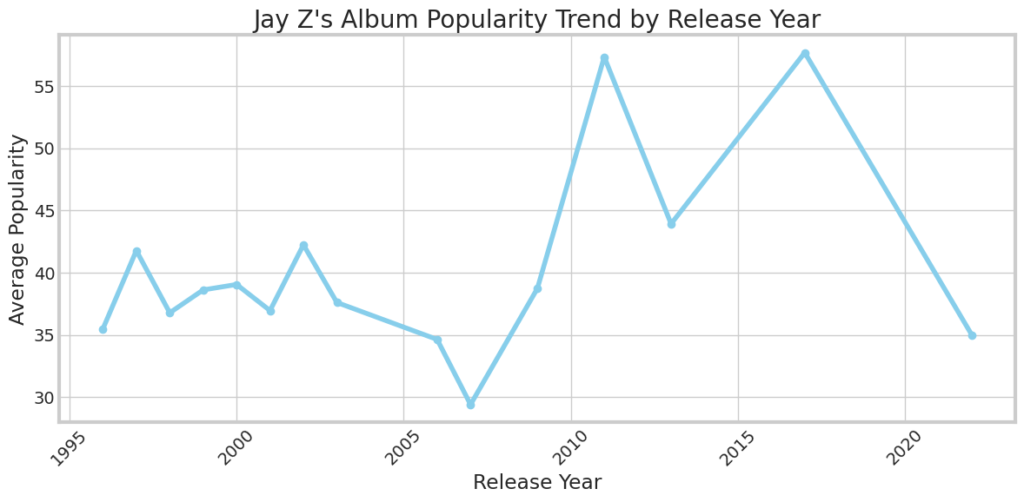
Digging into Jay-Z’s popularity trends across the years his albums dropped reveals some fascinating shifts. Particularly from 2011 to 2017, a period marked by bangers like ‘Ni**as in Paris’, there was a clear spike in how much his albums were vibing with audiences, showing a strong connection and increased engagement with his tunes. But, as time moved on, there’s been a bit of a dip in album popularity, suggesting maybe a change in what listeners are into or other outside influences changing how we all get into music. This shift lines up pretty neatly with major moves in the music world, like Spotify jumping onto the scene and streaming really hitting its stride between the mid-2010s and 2019, likely playing a part in these trends.
The data also points out an interesting phase from 2005 to 2010 where Jay-Z’s albums didn’t connect as well in terms of popularity compared to other years. This suggests there were some ups and downs in how people were feeling about his music during that time, which could have been swayed by several factors including changes in the culture or Jay-Z switching up his musical approach. The release of ‘Kingdom Come’, which was not well received, might have also influenced how fans were tuning into his music around then.
All in all, these insights shed light on the rhythm of Jay-Z’s music popularity over time and open up new paths to explore what’s been steering these trends.
Correlation
In exploring the analysis of Jay’s most popular albums, which include “Watch the Throne,” “4:44,” “The Blueprint 3,” “The Black Album,” and “Watch the Throne (Deluxe),” one pivotal aspect to consider is the correlation between their popularity and various features within the dataset. By juxtaposing this popularity data with other features such as release year, energy, loudness, and sales figures, we can discern patterns and potential insights into what contributes to the enduring allure of his music.
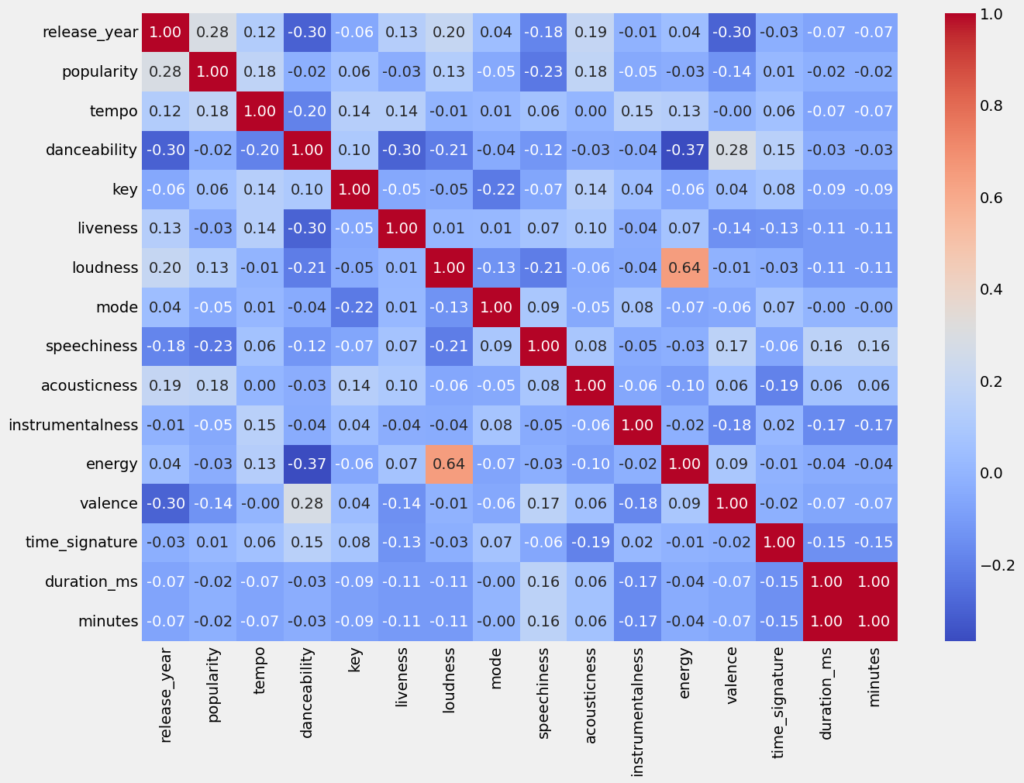
Upon examining the correlation chart, it’s evident that the relationship between release year and album popularity exhibits a relatively weak correlation coefficient of only 0.16. This modest correlation suggests that the temporal aspect of album release has limited influence on its overall popularity. Instead, it implies that other factors, such as thematic content (i.e. American Gangster), musical style, and promotional strategies, play a more substantial role in shaping its reception among listeners.
This finding underscores the dynamic nature of music consumption trends and highlights the importance of considering multiple dimensions when analyzing the success of an artist’s work over time.
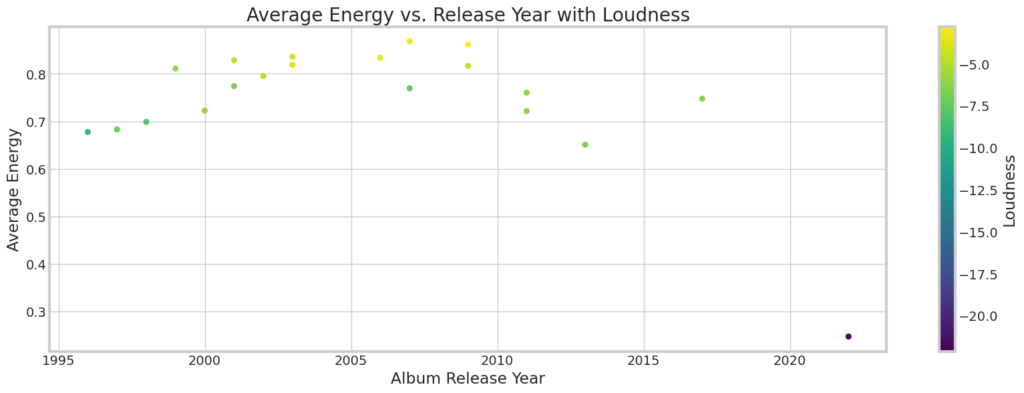
With a coefficient of .64, the correlation between energy and loudness stands out as the most robust positive correlation in Jay’s catalog. This significant discovery sheds light on a pivotal era from 2000 to 2010, marked by competition among producers and engineers to maximize the volume and intensity of recordings, known as the “loudness wars.” Jay-Z’s albums from this period, distinguished by their high energy and loudness levels, exemplify this sonic arms race, showcasing aesthetic preferences and production techniques of the time.
However, the observed decline in both energy and loudness in Jay-Z’s more recent projects, post 2010, signals a departure from the intensity and volume levels characteristic of the “loudness wars” era. This shift aligns with broader industry trends and evolving attitudes towards sound quality and dynamics in music production.
In recent years, the negative impact of excessive loudness on sound quality and the listening experience has been increasingly acknowledged, leading to a renewed interest in more nuanced and dynamic recording techniques. As artists and producers adapt to this evolving auditory environment, they are experimenting with a wider array of sound palettes and tonal textures. This endeavor aims to resonate with modern audiences by harnessing the subtleties and intricacies of quieter, more dynamic recordings, thus embracing a more sophisticated approach to music production.
RIAA Sales
Diving into the nexus of sales and popularity unveils a rich tapestry for dissecting an artist’s journey through the realms of commercial triumphs and cultural resonance. In the case of Jay-Z, a titan whose musical odyssey stretches over decades, embracing a myriad of styles and narratives, this exploration into the harmony between RIAA sales and the waves of popularity he rides offers a textured understanding of how his artistry has been embraced by listeners across eras. It’s a captivating look at the dialogue between an icon’s evolving soundscape and the audience’s reception, illuminating the intricate dance of influence and acclaim in Jay-Z’s storied career.
NOTE: The RIAA provides the most comprehensive data on U.S. recorded music revenues and shipments dating all the way back to 1973.

With a correlation coefficient of 0.69 between sales and popularity, this analysis reveals a moderately strong positive relationship between these two variables. This finding suggests that, in general, albums with higher levels of popularity tend to achieve greater sales figures. However, it’s important to note that correlation does not imply causation, and other factors may also contribute to album sales beyond popularity alone. While the correlation coefficient indicates a notable association between sales and popularity, it’s imperative to gain a comprehensive understanding of their relationship in the context of Jay-Z’s catalog.
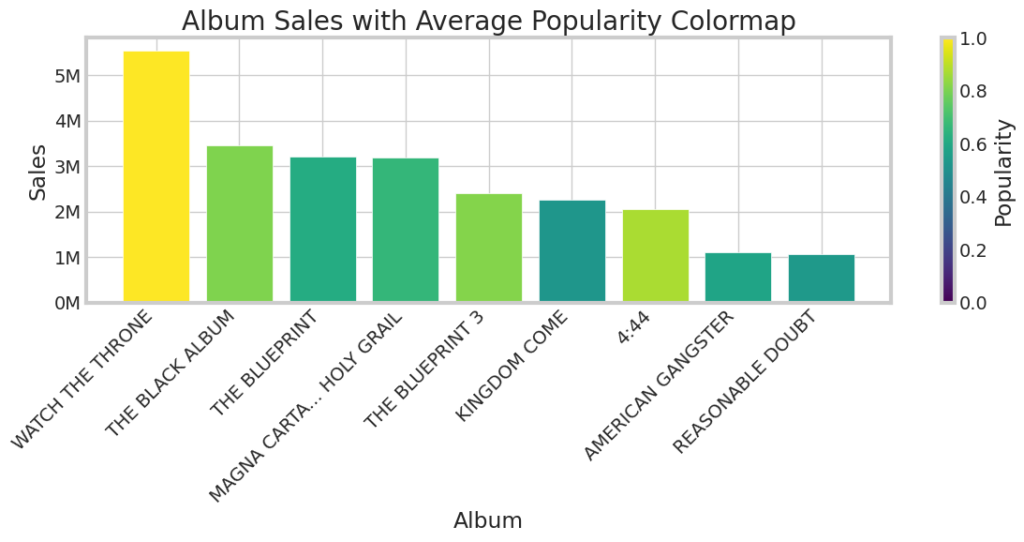
The deep dive into the chart before us unravels the complex interplay between album popularity and sales, especially against the backdrop of seismic shifts in the music landscape, like Spotify’s emergence as a streaming powerhouse. This moment of transition, where digital streaming began to eclipse physical album sales as the go-to revenue stream by 2018, adds a critical layer of context to our understanding of how popularity and sales intertwine within the ever-evolving currents of industry trends and tech innovations.
Take “Watch the Throne” as an example; it’s a clear case where popularity and sales move hand in hand, yet this isn’t a universal pattern across Jay-Z’s discography. The variance in how different albums perform sales-wise peels back the layers on the complexity of achieving commercial success in today’s music industry. Factors such as how an album is marketed, its distribution avenues, and listener preferences play significant roles, stretching beyond the simple measure of popularity.
Moreover, the strategic maneuvers behind album releases, exemplified by Jay-Z’s collaboration with Sprint for “4:44″—where Sprint’s acquisition of a million copies directly influenced its RIAA sales certification—highlight the nuanced ways in which sales figures can be influenced, merging traditional sales with promotional strategies in a manner that reshapes our understanding of commercial success.
Conclusion

My exploration into Jay-Z’s discography uncovers not just trends but the intricate dynamics that define his musical journey, emphasizing the need to blend contextual insights with statistical analysis for a fuller picture of his evolution.
During the “loudness wars,” a notable link emerged between the energy and loudness of his albums, mirroring the industry’s push for more intense sound levels, which significantly influenced Jay’s signature style.
The connection between album popularity and sales underscores the myriad of elements that dictate commercial success. Beyond just critical acclaim, factors like marketing strategies, distribution methods, partnerships, and listener preferences play crucial roles, pointing to the music industry’s layered commercial fabric.
Furthermore, the advent of Spotify has left a distinct mark on Jay-Z’s work. Streaming has not only expanded his music’s reach but also introduced a disparity in popularity between his pre and post-Spotify releases. This shift illustrates the profound effect digital platforms have on how music is consumed and valued, marking a new era of measuring success within the industry.